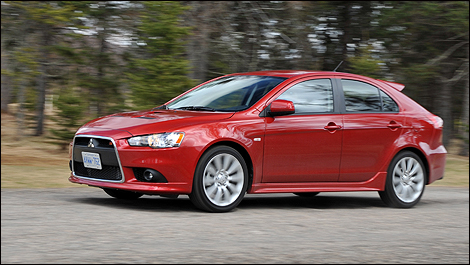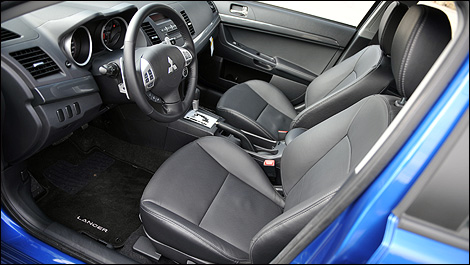Mont-Tremblant, PQ - Canadians like hatchbacks. The time is right for Mitsubishi for reintroduce the
Lancer Sportback, but this time, it's different from the pseudo-wagon model that wasn't quite popular during the Lancer's previous generation.
So the new Sportback is basically a five-door spin-off of the
sedan that's selling in growing numbers in our country. Mitsubishi moved out over 8,600 Lancer four-doors in 2008, and they expect to sell about 1,000 copies of the Sportback during their current fiscal year. That sounds like a conservative figure, but the Japanese brand isn't offering a stripper model--for now.
Two flavours to choose fromThe Sportback is available in either GTS or Ralliart trim, and share the sedan's powertrain and equipment levels.
The GTS is powered by a 2.4-litre inline-4 that develops 168 horsepower and 167 lb-ft of torque, and our test car was equipped with the optional CVT automatic. The car has more than enough guts to move along swiftly, and at wide-open throttle, the engine isn't too trashy despite the CVT holding the tach needle near the redline. Using the wheel-mounted paddle shifters, gear changes are pretty quick.
The Ralliart, on the other hand, gets a turbocharged 2.0-litre 4-cylinder, basically a detuned version of what's found lurking in the Evolution's snout. Its 237 horsepower but 253 lb-ft of torque at a relatively low 2,500 rpm translates into moderate turbo lag and monster acceleration thereafter, while the dual-clutch sequential transmission bangs through shifts with a race-car attitude; it's a little harsh, so you gotta like it.
All-wheel drive is also standard on the Ralliart and is a setup similar to the Evolution's, but doesn't include Active Yaw Control or AYC, which is a rear differential that manages power between the left and right wheels. Big deal.
Handling is pretty sharp on both models, while the Ralliart is obviously more willing to be pushed to its limits on sinuous back roads. Either one is fun to drive, though we prefer the ride of the GTS for everyday use.
Same dash, different seatsBetween the two versions, most distinctions on the inside concern the seats and other bits and pieces. The GTS gets cloth sport seats and offers optional leather surfaces, while the Ralliart is graced with ultra-embracing Recaro chairs. While we prefer the latter for the added comfort and lateral support, they are harder to get out of and aren't height-adjustable.
Both versions have their own steering wheel, but the rest of the dashboard is the same. Bluetooth and SIRIUS are standard on the GTS but optional on the Ralliart, as part of the latter's available package that includes a navigation system. A power sunroof and a 650-watt stereo are available on both models.
Cargo space with the rear seatbacks down totals 1,320 litres in the Ralliart but 1,492 litres in the GTS, thanks to a load floor that can be adjusted 90 mm lower. In comparison, that's slightly more room than in the Toyota Matrix, the
Mazda3 Sport, the Saturn Astra and the Dodge Caliber but less than in the Hyundai Elantra Touring.
Pricing and competitionThe Lancer Sportback GTS starts at $23,498 with the 5-speed manual. Options include the $1,300 CVT automatic and $2,700 Sun and Sound Leather Package. The Ralliart starts at $33,498, while a $5,000 Premium Package is optional.
The GTS is expected to count for 70 percent of Sportback sales, but the Canadian operations are working hard to convince Japanese headquarters that building an SE model with a 2.0-litre engine is a good idea. That base model would cost about $20,500 and should turn up at the 2010 Montreal Auto Show if all goes well.
According to Mitsubishi, the GTS will rival the Mazda3 Sport and Toyota
Matrix, while the Ralliart will battle the Mazdaspeed3 and Subaru
Impreza WRX.
ConclusionSo, the Sportback obviously has all the virtues of the Lancer sedan but with more cargo space. Some of us aren't quite convinced with the car's overall shape, though, as the sloping backlight and stretched rear end look a little peculiar. The hatchback may add $500 to the price of the car, but for the extra versatility, we think it's worth it.



